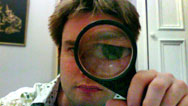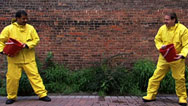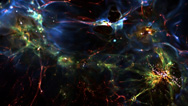Dark Matter
- Posted 06.25.08
- NOVA scienceNOW
(This program is no longer available for online streaming.) Host Neil deGrasse Tyson reports from a half mile underground in an abandoned mine, where scientists are using special detectors to look for evidence of a ghostly substance that they believe makes up most of the matter of the universe—a hypothetical entity called dark matter.
Transcript
DARK MATTER
PBS Airdate: June 25, 2008
NEIL deGRASSE TYSON: Hi. I'm Neil deGrasse Tyson. Welcome to a new season of NOVA scienceNOW.
Now, I'm an ordinary guy, and that means, of course, I'm made up of ordinary matter: basically, atoms. And when we gaze out into space, everything we see—galaxies, stars—is also ordinary, made of atoms.
But a lot of scientists say there's something else in the universe that's NOT ordinary.
Wait, who said that?
NEIL'S JACKET SLEEVE: And by the way, there seems to be way more of this weird stuff than ordinary guys like you...
NEIL deGRASSE TYSON: Hey, watch it!
And even though it's invisible, it's getting harder and harder to ignore.
Every day, a crew squeezes into an 80-year-old elevator in Minnesota and commutes to work a half a mile down, into the depths of an abandoned mine.
They're not searching for gold or diamonds. Instead, they're mining for something even more coveted and harder to find, something called dark matter.
RICHARD MASSEY: Dark matter is one of the biggest mysteries.
TALI FIGUEROA: Dark matter is everywhere.
RICHARD MASSEY: We wouldn't be here if it weren't for the dark matter. Life wouldn't be possible.
TALI FIGUEROA: The problem is we have no clue what the dark matter is.
JOCELYN MONROE (Massachusetts Institute of Technology): We know it's out there, and we just have to find it.
NEIL deGRASSE TYSON: One of the people now trying to find dark matter is physicist Tali Figueroa.
TALI FIGUEROA: Discovering dark matter is going to be one of the greatest finds of the century.
NEIL deGRASSE TYSON: So, they really mine iron in this place.
His search takes place a half-mile under ground, where this old iron mine has been transformed into a cavernous, space-age physics lab.
When I visited, I didn't notice any dark matter, but I did see quite a bit of dead matter.
Whoa, what is this thing?
TALI FIGUEROA: That's a bat.
NEIL deGRASSE TYSON: It doesn't look very alive.
TALI FIGUEROA: Probably isn't.
NEIL deGRASSE TYSON: Whoa, there's one there...another, another.
TALI FIGUEROA: They're all over the place.
NEIL deGRASSE TYSON: That's nasty.
TALI FIGUEROA: It is, kind of.
NEIL deGRASSE TYSON: Nasty. So that doesn't creep you out?
TALI FIGUEROA: You get used to it.
NEIL deGRASSE TYSON: Down here, surrounded by the dead bats, Tali and his colleagues monitor and care for a complex contraption specially designed to detect particles of dark matter.
So this is it, huh?
TALI FIGUEROA: Yup.
NEIL deGRASSE TYSON: This elaborate endeavor is all to solve a mystery that's been plaguing astrophysicists for more than 70 years.
It might seem bizarre and even a bit crazy, but there's a chance that most of the matter in the universe is not stars or planets or gas or anything familiar to us, but is in the form of some mysterious invisible substance. We've labeled it "dark matter," but why do we think it exists at all?
It comes down to gravity and speed. Ever since Isaac Newton, we've known that it's gravity that holds objects in orbit, just as the sun holds Earth and the rest of the planets.
The stronger the gravity pulling it inward, the faster an object can go and stay in orbit. It's kind of like spinning a heavy ball around: the harder you pull on the ball, the faster the ball will travel. If the ball gets moving too fast, even a strong guy like this has got to let go.
PETER FISHER (Massachusetts Institute of Technology): The faster you want something to go—like, you know, David throwing his slingshot—the more you have to pull on it. And the thing that's pulling on something to make it orbit is gravity.
NEIL deGRASSE TYSON: And where does gravity come from? Well, we know it can be things with mass like stars, houses, planets, trains, clouds, jellyfish; they all have gravity.
So, in the universe, the more stuff, the more gravity, and the faster objects can move and remain in their orbits. The problem is when we look out beyond our solar system, like at stars orbiting within galaxies, or galaxies moving within galaxy clusters. They're all orbiting faster than we'd expect.
JOCELYN MONROE: The speed at which the stars are going around at is too fast. You would expect that it should just escape, but those stars don't escape. They're still going around.
NEIL deGRASSE TYSON: There's got to be a lot of gravity holding them all together, but apparently there's not enough matter to account for it.
PETER FISHER: And there's not enough stuff. There's just not enough stuff to keep them all going around each other.
NEIL deGRASSE TYSON: Regardless of how we probe the cosmos for this missing matter—using visible light, radio waves, x-rays—we still come up short. Either we've got the laws of gravity completely wrong, or there's got to be more stuff. Actually, we'd need about five times more stuff. It's stuff we can't see, but what exactly is it?
RICHARD MASSEY: What is dark matter?
MAX TEGMARK (Massachusetts Institute of Technology): What is the dark matter?
RICHARD MASSEY: Yeah, that is a big question.
TALI FIGUEROA: We don't know what it is.
RICHARD MASSEY: It's completely invisible.
TALI FIGUEROA: It's dark. It doesn't glow.
MAX TEGMARK: So, whatever the dark matter is...
TALI FIGUEROA: We can't point a telescope up and actually see it.
MAX TEGMARK: ...it sure ain't made of atoms.
NEIL deGRASSE TYSON: Everything around us that we can see and touch, ordinary matter, is made of atoms. But one thing we know is dark matter is not ordinary.
RICHARD MASSEY: We know its not ordinary matter, because ordinary matter has all this whole other variety of interactions. It has electric fields and magnetic fields. It emits light.
NEIL deGRASSE TYSON: One idea is, since it's not made of ordinary atoms, dark matter might be made of some exotic particle. Right now, physicists around the world are racing to build a detector sensitive enough to capture one, so they can figure out exactly what it is.
But how do you catch a particle that's so shy?
TALI FIGUEROA: The fundamental problem is that this dark matter does not interact with matter very much. And so, in order to detect it, we have to build these really specialized, very sensitive detectors.
NEIL deGRASSE TYSON: At this underground lab, Tali Figueroa is monitoring one kind of dark matter detector, a superconducting crystal made from the element germanium.
So, one of your detectors, huh?
TALI FIGUEROA: Yes, this is a prototype of one of the 30 detectors. And when you look at the surface of our detector, you'll see a metal grid.
NEIL deGRASSE TYSON: The grid picks up tiny temperature changes, produced when a particle hits the crystal and sets all its atoms vibrating. But to detect those vibrations, the atoms in the crystal have to start out as still as possible, something atoms don't normally like to do.
TALI FIGUEROA: The problem is that naturally, at room temperature, the atoms are vibrating themselves.
NEIL deGRASSE TYSON: So, how does the team manage to slow down the detector's atoms? They put it in a freezer, a very powerful freezer.
So the whole point of this is to simply keep the experiment cold?
TALI FIGUEROA: Yes. We have to keep the experiment at about 50 milliKelvin, which is 50/1000 of a degree above absolute zero.
NEIL deGRASSE TYSON: Just a fraction of a degree above absolute zero? Translated into Fahrenheit, that's, like, 460 degrees below zero. So, in other words, it's cold enough so that the air we breathe freezes solid.
TALI FIGUEROA: Absolutely.
NEIL deGRASSE TYSON: And so there's frost everywhere.
But now there's another problem. The frozen detector is so hyper-sensitive, lots of things could set it off, like cosmic rays, particles that shower Earth from space. So this is why the whole lab is deep under ground.
So the bedrock...
TALI FIGUEROA: The half a mile of rock...
NEIL deGRASSE TYSON: ...above...
TALI FIGUEROA: ...is a shield.
NEIL deGRASSE TYSON: ...is a shield. So the cosmic rays...these are high energy particles from space?
TALI FIGUEROA: From space.
NEIL deGRASSE TYSON: Okay. So you're protecting yourself from space.
And it's not just cosmic rays. Even under ground, there are other tiny particles flitting around us, including photons and neutrons that can fly out of the surrounding rock. So the detectors are cloaked in layer upon layer of shielding, all in an effort to filter out everything but the dark matter. And how are things going so far?
Okay, how many dark matter particles have you found so far?
TALI FIGUEROA: None.
NEIL deGRASSE TYSON: None?
TALI FIGUEROA: None.
NEIL deGRASSE TYSON: It's not too surprising. The quest for dark matter here on Earth has only just begun, and bigger and more sensitive detectors are already in the works. Still, you might wonder, could it be that dark matter is something that's just out there in space and not down here with us?
Astrophysicist Richard Massey says, "not likely." He's got the first-ever, 3-D dark matter maps to back him up. But how do you map the unseeable?
RICHARD MASSEY: So we can't see dark matter directly; it's completely invisible. But we can work out where it is by its effects on the ordinary matter that we can see.
NEIL deGRASSE TYSON: In other words, you can see dark matter's gravity. That's because, according to Einstein and nearly a century of experiments, what gravity does in the universe is bend space. Massive objects like the sun actually bend and stretch the contours of space. That's what keeps smaller objects, like Earth, in orbit.
And if space is bent, so is any light that passes through it.
RICHARD MASSEY: So let's debunk the whole idea that light travels in straight lines. Light travels in what it thinks are straight lines. And because space is warped and bent, even the straight lines that light rays travel along are actually bent themselves.
NEIL deGRASSE TYSON: The phenomenon is called gravitational lensing. Think of what a thick magnifying glass can do the text of a book.
RICHARD MASSEY: When we put a magnifying glass in front of it, we start seeing a distorted image, and gravitational lensing to find dark matter works in a very similar way.
NEIL deGRASSE TYSON: A huge clump of dark matter and the enormous gravity it creates would bend areas of space so much, it would act like a giant cosmic lens, distorting our view of distant galaxies.
The more distortion, the more gravity, and, Massey assumes, the more dark matter lies between them and us.
RICHARD MASSEY: So, the final result is that we end up having this map of where the dark matter is in the universe.
NEIL deGRASSE TYSON: Maps such as these are now revealing that galaxies like ours are completely enveloped by giant clouds of dark matter.
RICHARD MASSEY: Wherever there's ordinary matter, so even here, there is some dark matter. It's everywhere. The two really have gone together, hand in hand.
NEIL deGRASSE TYSON: In fact, as the universe evolved after the Big Bang, dark matter may have served as a kind of cosmological glue that, over time, helped pull stars together to form galaxies.
RICHARD MASSEY: We owe everything to dark matter, in two ways: firstly, it holds the whole universe together; but then it also, crucially...inside that, it forms this scaffolding in which the ordinary matter can lay to grow.
MAX TEGMARK: We are so lucky to have dark matter, because we wouldn't even be here otherwise. It was the gravitational attraction from dark matter that pulled together this diffused gas that eventually formed our Milky Way galaxy that we live in. And if there were no dark matter, then our galaxy would, in fact, never have formed.
NEIL deGRASSE TYSON: If that's true, then it's not just our Milky Way. Across the universe, none of the billions of galaxies out there would have formed without the gravity of this mysterious stuff.
Now, we just need to find out what it is.
MAX TEGMARK: It's really astonishing that there's five times more stuff out there than we know of, and that we've been at this, as a community, for over 70 years. And yet it might be now, in the next few years, that we'll figure it all out. It's just incredible.
Credits
Dark Matter
- Edited by
- Doug Quade
- Written, Produced and Directed by
- Julia Cort
NOVA scienceNOW
- Executive Producer
- Samuel Fine
- Executive Editor
- Neil deGrasse Tyson
- Senior Series Producer
- Vincent Liota
- Supervising Producers
- Stephen
Sweigart
Joey David - Editorial Producer
- Julia Cort
- Development Producer
- Vinita Mehta
- Senior Editor
- David Chmura
- Production Assistant
- Fran Laks
- Compositors
- Brian Edgerton
Yunsik Noh - Music
- Rob Morsberger
- Associate Producers
- Fran Laks
Molly Longstreth
Anthony Manupelli
Win Rosenfeld
Alison Snyder - Assistant Editor
- Susan Perla
- Camera
- Jim Ball
James Callanan
Austin deBesche
Brian Dowley
Vincent Liota
Steve McCarthy - Sound Recordists
- Bernie Beaudry
Lauretta Molitor
Roger Phenix
George Shafnacker
Tom Williams - Sound Mix
- David Chmura
- Animation
- Sputnik
Animation
James LaPlante
Brian Edgerton
Anthony Kraus
Yunsik Noh
"The Forgetting," Twin Cities Public Television - Production Manager For Crowd Segment
- Candace White
- Segment Production Assistants
- Mona
Damluji
Grisha Enikolopov - NOVA scienceNOW series animation
- Edgeworx
- Three dimensional brain animation
- Courtesy Dr. Arthur W. Toga, Laboratory of Neuro Imaging at UCLA
- Archival Material
- ESA
Jet Propulsion Laboratory
Library of Congress
NASA - Special Thanks
- Briarwood
Healthcare and Rehabilitation Center, Needham, MA
Douglas Clowe
Bamidele Faboyede
Prasad Jayanti
Kimo Johnson
Eric Kee
Sue Moen
Soudan Underground Mine - A Minnesota State Park
Twin Cities Public Television
Jeff Woodward - Neil deGrasse Tyson
- is director of the Hayden Planetarium in the Rose Center for Earth and Space at the American Museum of Natural History.
- NOVA Series Graphics
- yU + co.
- NOVA Theme Music
-
Walter Werzowa
John Luker
Musikvergnuegen, Inc. - Additional NOVA Theme Music
- Ray
Loring
Rob Morsberger - Post Production Online Editor
- Spencer Gentry
- Closed Captioning
- The Caption Center
- NOVA Administrator
- Ashley King
- Publicity
- Carole McFall
Eileen Campion
Lindsay de la Rigaudiere
Victoria Louie
Kate Becker - Senior researcher
- Gaia Remerowski
- Production Coordinator
- Linda Callahan
- Paralegal
- Raphael Nemes
- Talent Relations
- Scott Kardel, Esq.
Janice Flood - Legal Counsel
- Susan Rosen
- Post Production Assistant
- Darcy Forlenza
- Associate Producer, Post Production
- Patrick Carey
- Post Production Supervisor
- Regina O'Toole
- Post Production Editors
-
Rebecca Nieto
Alex Kreuter - Post Production Manager
- Nathan Gunner
- Compliance Manager
- Linzy Emery
- Supervising Producer
- Stephen Sweigart
- Business Manager
- Joseph P. Tracy
- Producers, Special Projects
- Lisa Mirowitz
David Condon - Coordinating Producer
- Laurie Cahalane
- Senior Science Editor
- Evan Hadingham
- Senior Series Producer
- Melanie Wallace
- Managing Director
- Alan Ritsko
- Senior Executive Producer
- Paula S. Apsell
This material is based upon work supported by the National Science Foundation under Grant No. 0638931. Any opinions, findings, and conclusions or recommendations expressed in this material are those of the author(s) and do not necessarily reflect the views of the National Science Foundation.
NOVA scienceNOW is a trademark of the WGBH Educational Foundation
NOVA scienceNOW is produced for WGBH/Boston by NOVA
© 2008 WGBH Educational Foundation
All rights reserved
- Image credit: (dark matter animation) © WGBH Educational Foundation
Participants
- Neil deGrasse Tyson
- Astrophysicist, American Museum of Natural History
- Enectali Figueroa-Feliciano
- Massachusetts Institute of Technology web.mit.edu/physics/facultyandstaff/faculty/tali_figueroa-feliciano.html
- Peter Fisher
- Massachusetts Institute of Technology web.mit.edu/physics/facultyandstaff/faculty/peter_fisher.html
- Richard Massey
- Royal Observatory Edinburgh, U.K. www.astro.caltech.edu/~rjm/cv.php
- Jocelyn Monroe
- Massachusetts Institute of Technology
- Max Tegmark
- Massachusetts Institute of Technology web.mit.edu/physics/facultyandstaff/faculty/max_tegmark.html
Related Links
-

Dark Matter: Expert Q&A
Astronomer Richard Massey answers questions about dark matter and other otherworldly enigmas.
-

The Dark Matter Mystery
See how a cosmic collision provides evidence that dark matter really exists.
-

In Pursuit of Dark Matter
We're about 12 million cosmic ray collisions from better understanding dark matter, say physicists at CERN.
-

Gamma Rays and Dark Matter
Gamma rays from a dwarf galaxy may help astronomers solve the riddle of dark matter.



